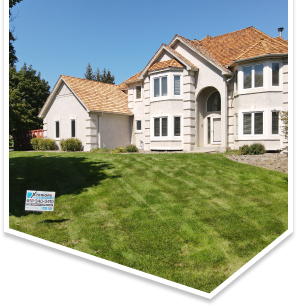Making your garage cozier and more energy-efficient starts with insulating the roof. Whether you use your garage for storage, parking, or as a workshop, proper insulation can lower energy costs, regulate temperature, and protect your belongings from the weather.
If you’ve been wondering how to insulate a garage roof, you’re in the right place. This blog post covers all about garage roof insulation and a step-by-step approach to properly insulating your garage roof.
What is Garage Roof Insulation, And Why Is It Important?
Adding insulating materials to a garage roof creates a thermal barrier. By lowering heat transfer, this helps control internal temperatures, making the garage warmer in the winter and cooler in the summer.
It improves energy efficiency and shields stored goods from dampness and harsh temperatures by reducing the effects of external weather. In the end, adequate insulation reduces energy expenses while creating a more cozy and useful garage.
Why Is Garage Insulation Important?
Here’s how insulating your garage can benefit you:
- Protection of Belongings: Shields items from temperature extremes and moisture, extending their lifespan.
- Moisture Control: Prevents condensation buildup and reduces the risk of mold growth.
- Fire Resistance: Some insulation materials offer fire-resistant properties, improving safety.
- Noise Reduction: Acts as a sound barrier, minimizing noise between the garage and living areas.
- Increased Property Value: Improves home efficiency, which could boost your property’s value.
- Energy Efficiency: Reduces heat loss in winter and heat gain in summer, helping lower energy bills.
- Comfort: Makes the garage a more comfortable space for various activities.
- Enhanced Durability: Protects roofing materials from extreme temperatures and moisture, extending their lifespan and cutting maintenance costs.
- Improved Air Quality: Helps prevent mold and mildew, leading to healthier indoor air.
- Versatile Usage: Allows the garage to serve as a gym, office, or hobby space, beyond just vehicle storage.
- Reduced HVAC Load: Stabilizes temperatures in the garage, easing the demand on heating and cooling systems in your home.
Also Read: 3 Tips For A Successful Garage Roof Repair Project
What Are The Different Types of Garage Roofs?
Understanding the different types of garage roofs can help you choose the best insulation option:
A. Flat Roofs
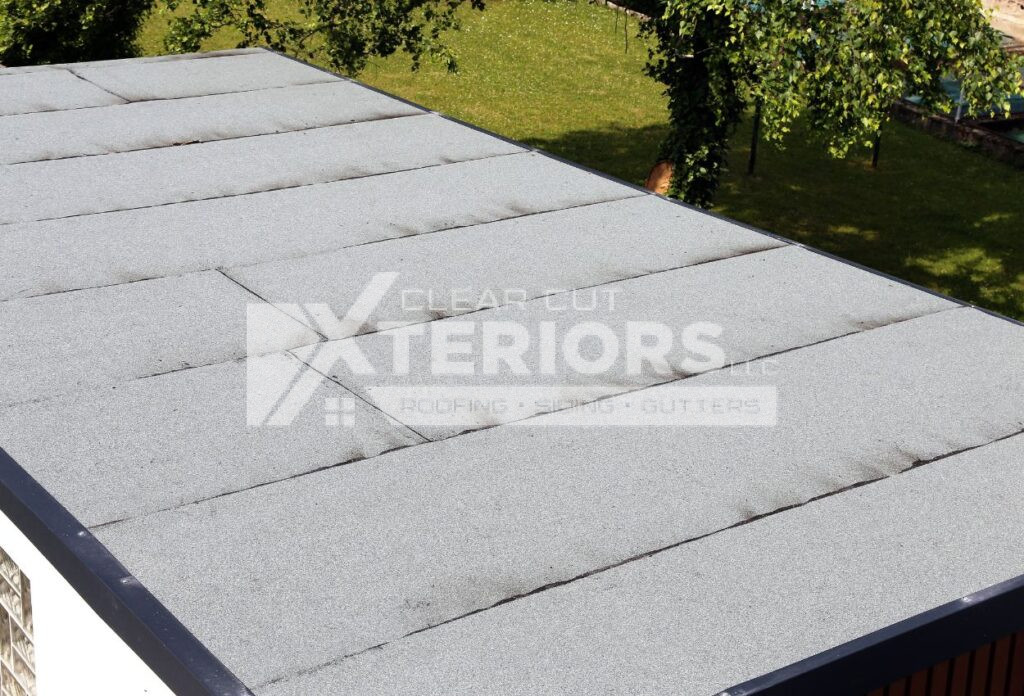
Known for their minimal slope, flat roofs can experience water pooling if not maintained well. Built with materials like plastics or rubber, they are affordable and easy to install. However, proper drainage is essential to prevent leaks and structural issues.
B. Pitched Roofs
With their sloped design, pitched roofs efficiently drain water, lowering the risk of leaks. They also provide extra headroom and usable space, making them practical and visually appealing. Insulation, often installed between rafters using fiberglass batts or rigid foam boards, enhances thermal performance and reduces heat loss. This design improves ventilation and works with a variety of roofing materials, offering flexibility.
Best Materials For Insulating a Garage Roof
Now, let’s take a look at the best materials available for insulating your garage roof and their pros and cons:
#1. Rigid Foam Insulation

Known for its high efficiency, rigid foam insulation comes in types like XPS and polyiso, with an R-value of R-3.9 to R-8 per inch. Its moisture resistance makes it ideal for damp areas, though precise cutting is needed for proper installation. This is a great solution for anyone insulating a garage in humid climates.
Pros
- High R-value per inch, great thermal performance.
- Moisture and pest-resistant, preventing mold.
- Durable, stays in place after installation.
Cons
- Higher initial cost.
- Precise cutting needed around obstructions.
- Extra sealing may be required for air leaks.
#2. Cellulose Insulation
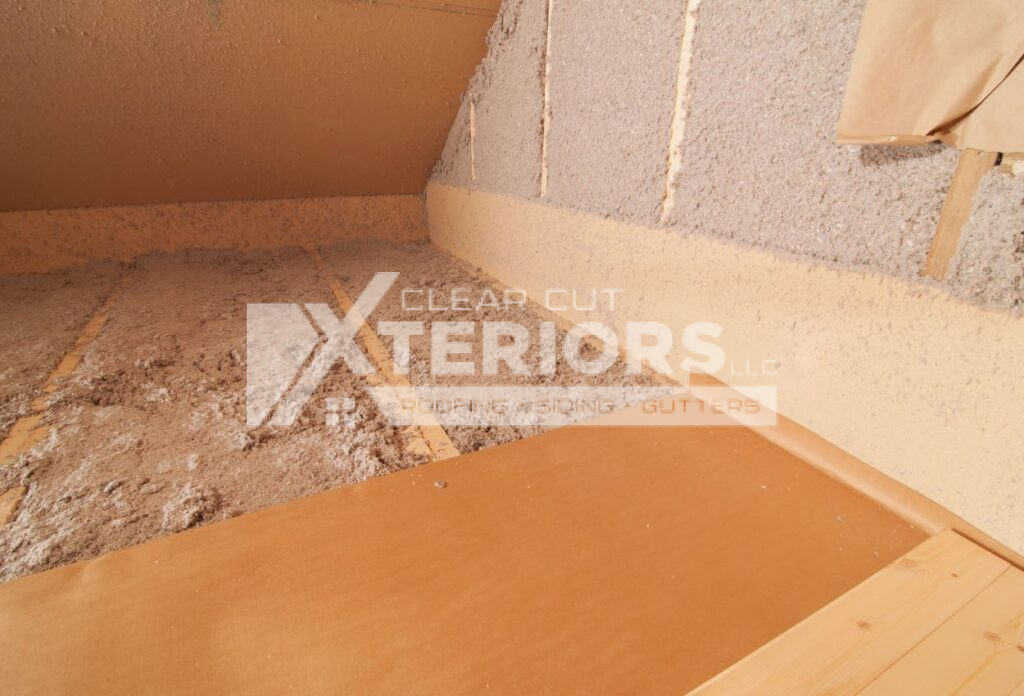
Made from recycled paper, cellulose is eco-friendly and offers an R-value of R-3.1 to R-3.8 per inch. It’s treated for fire and pest resistance but can absorb moisture, so a vapor barrier is essential. Its installation often requires specialized equipment, making it a sustainable option for those looking to insulate garage spaces.
Pros
- Eco-friendly, made from recycled materials.
- Fills gaps effectively, ensuring a snug fit.
- Good soundproofing.
Cons
- More expensive than fiberglass.
- Needs professional installation.
- May settle, reducing efficiency over time.
#3. Fiberglass Insulation
A popular choice due to its affordability and easy installation, fiberglass insulation comes in batts or loose-fill. With an R-value of R-2.2 to R-3.8 per inch, it offers good thermal resistance. However, without a vapor barrier, it can absorb moisture, reducing its effectiveness over time. Fiberglass is often considered the best garage insulation for those on a budget.
Pros
- Affordable and widely available.
- Fire-resistant and non-corrosive.
- Easy installation, especially in batt form.
Cons
- Vulnerable to moisture, leading to mold.
- Can irritate skin during installation.
- Lower thermal performance than rigid foam.
#4. Spray Foam Insulation
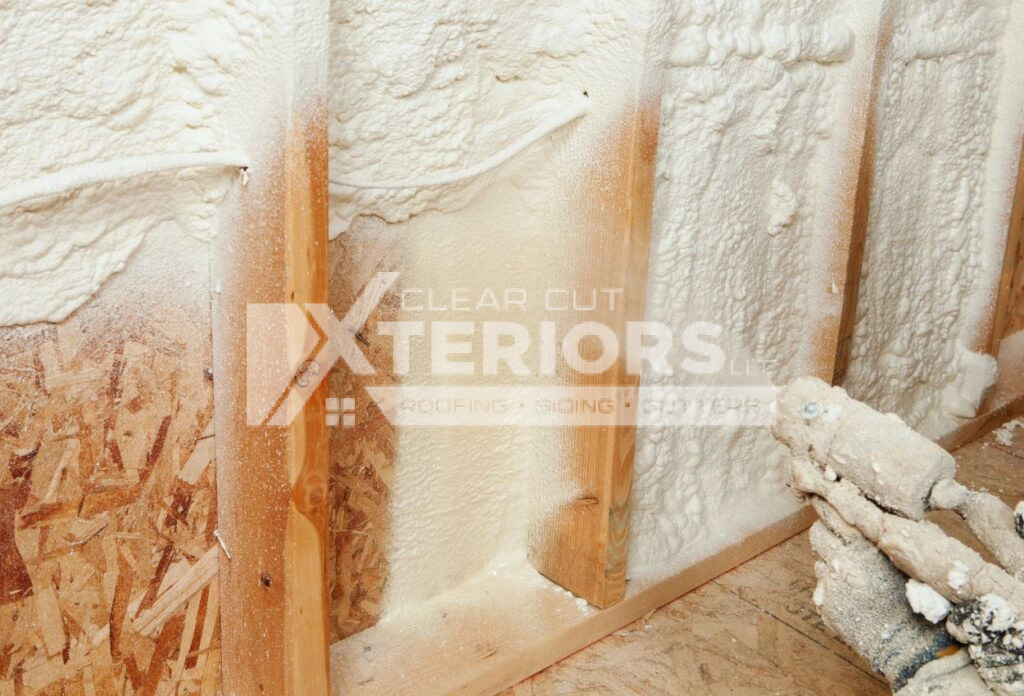
Spray foam expands to form an airtight seal, preventing air leaks and moisture. Open-cell spray foam has a strong R-value of R-3.6 to R-3.9 per inch. While effective, it is more expensive and typically requires professional installation. If you’re wondering how to insulate a garage roof for maximum energy efficiency, spray foam is a top choice.
Pros
- Creates an airtight seal, preventing air leakage.
- High R-value per inch, excellent thermal efficiency.
- Moisture-resistant, reducing mold risk.
Cons
- High upfront cost, requires professionals.
- Contains hazardous chemicals if mishandled.
- May cause overheating if the roof is not ventilated.
#5. Mineral Wool Insulation
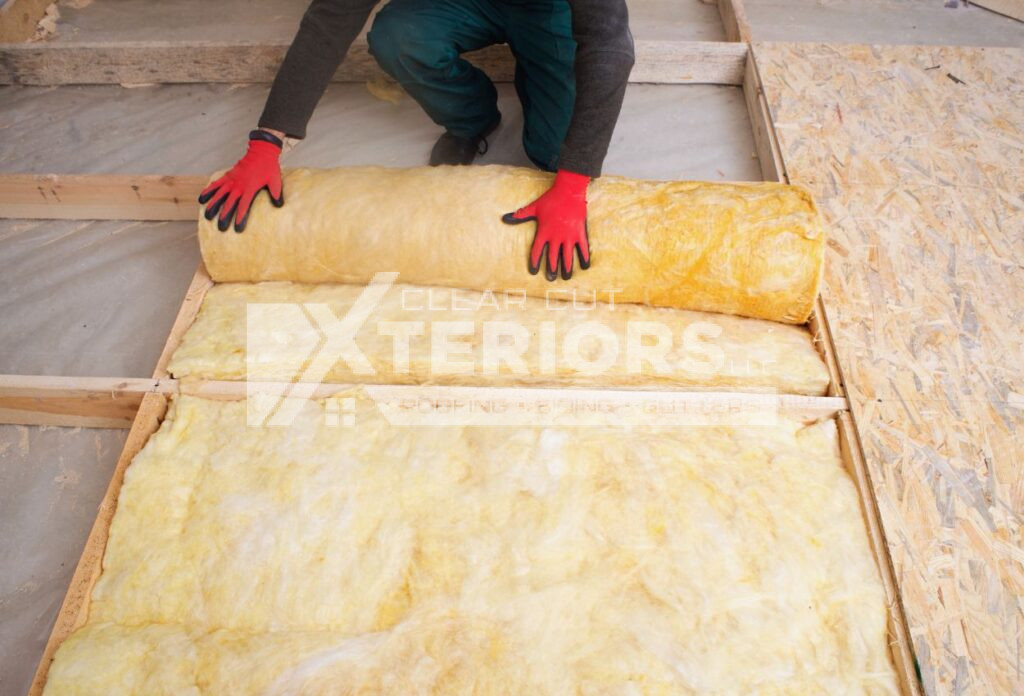
Made from rock or slag fibers, mineral wool offers excellent fire resistance and soundproofing. Its R-value ranges from R-2.2 to R-4.2 per inch. It resists moisture well without losing its insulating properties but can be pricier than fiberglass. For homeowners seeking durable garage insulation, mineral wool is worth considering.
Pros
- Great fire resistance and soundproofing.
- Water-repellent, preventing mold.
- Eco-friendly options available.
Cons
- More costly than fiberglass.
- Heavier, making installation harder.
- Can produce dust, requiring careful handling.
#6. Reflective Insulation
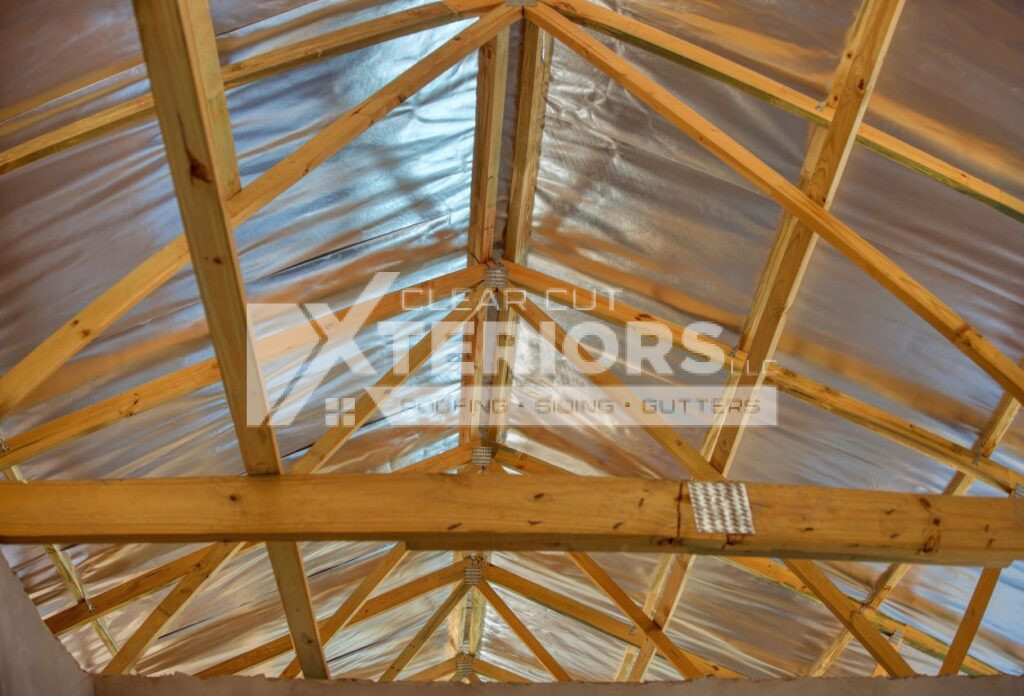
Reflective insulation uses aluminum foil to deflect radiant heat, making it effective in hot climates. It’s often paired with other materials to boost thermal performance, especially where reducing heat gain is a priority. This type of insulation works well when trying to insulate garage roofs in warmer areas.
Pros
- Reduces cooling costs by reflecting heat.
- Lightweight, easy to install.
- Enhances performance when paired with other types.
Cons
- Less effective in cold climates.
- Needs an air gap for best performance.
- May lack sufficient thermal resistance alone.
Also Read: Garage Roof Replacement: What to Expect During the Process
Step-By-Step Guide to Insulate a Garage Roof
While it’s always recommended to work with a professional, understanding how to insulate a garage can be helpful for homeowners. Here’s a step-by-step process for effectively insulating your garage roof:
Step 1: Check the Garage Roof
Inspect for Damage
Before starting, inspect the roof for leaks, sagging, or mold. Fix any issues to ensure a strong base for insulation.
Measure the Area
Measure the roof and the spacing between rafters. These measurements will help you choose the right insulation and determine how much you need. Once this is done, you can move on to selecting your insulation.
Step 2: Choose Your Insulation
Select the Best Option
Now, choose the insulation that suits your needs. Once you’ve picked your insulation, it’s time to prep the garage for installation.
Step 3: Prepare the Area
Clear the Space
Move cars, tools, and storage to make room for work.
Clean the Surface
Clean the roof and rafters, removing dust and mold to improve insulation performance. With a clear and clean workspace, you’re ready to install.
Step 4: Install the Insulation
Fit Between Rafters
Cut the insulation to fit snugly. Avoid compressing fiberglass batts to maintain their effectiveness.
Secure in Place
Staple fiberglass batts or use adhesive/screws for rigid foam. Check for gaps, as they can cause heat loss. If needed, proceed with adding a vapor barrier.
Step 5: Add a Vapor Barrier (If Needed)
Install the Barrier
In humid areas, place a vapor barrier on the warm side of the insulation. Seal all seams with tape to prevent moisture issues.
Step 6: Cover with Drywall
Attach the Drywall
Cover the insulation with 1/2-inch drywall, securing it with screws spaced about eight inches apart.
Finish and Paint
Tape seams, apply joint compound, sand smooth, and paint. This final step will protect the insulation and give your garage a polished look.
Tips for Maintaining Your Garage Roof Insulation
Below are some simple tips to maintain your garage roof insulation and ensure long-lasting efficiency:
1. Inspect Often
Check for moisture or pest damage regularly to keep insulation intact.
2. Keep Vents Clear
Remove debris around vents to ensure proper airflow.
3. Monitor Temperature
If temperatures fluctuate, reassess your insulation’s condition.
Insulate Your Garage Roof with Clear Cut Xteriors LLC
At Clear Cut Xteriors LLC, we focus on improving your home’s comfort and energy efficiency with expert roofing services, including garage roof insulation. Our experienced team will carefully assess your garage’s needs and suggest the best insulation option. Count on us for the best results and enhanced home performance. Call us today at (651) 340-3410 or click here for an instant quote!

